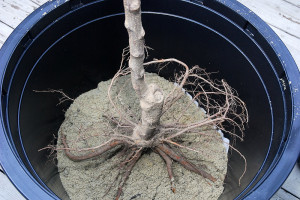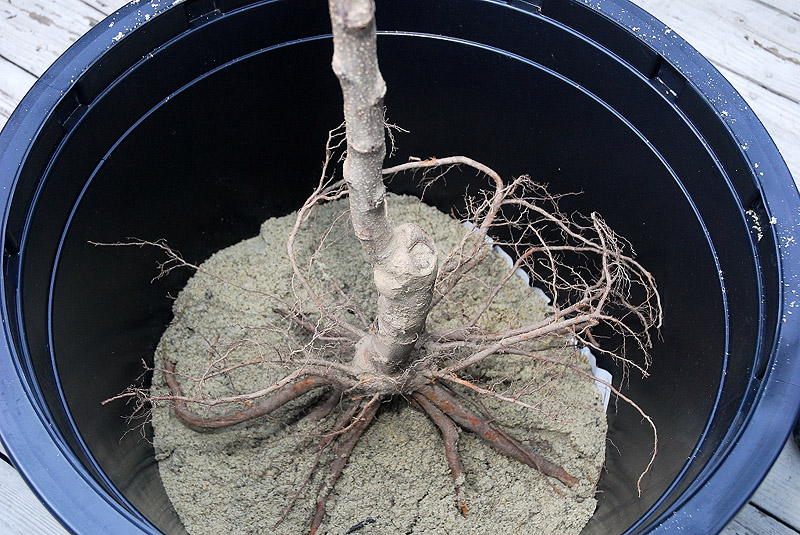Only a couple weeks into winter, and we’re already thinking about spring! The deer fence is up, and it’s time to stock the orchard! This last weekend our local garden nursery received their shipments of bare root fruit trees for the season. Time to hunt down the last of the fruit varietals we want to round out the orchard. Although we won’t plant for a couple of weeks while we wrap up some final site preparation, we did want to purchase our trees while we could have our pick of the best.
This year we’ve chosen to add the following varieties of fruit trees to our existing stock (root stocks in parentheses):
‘Honey Crisp’ Apple (M-111)
‘Granny Smith’ Apple (M-111)
‘Bosc’ Pear (OHxF333)
‘Blake’s Pride’ Pear (OHxF333)
‘Flavor Delight’ Aprium (Myro 29C)
‘Flavor King’ Pluot (Citation)
‘Flavor Supreme’ Pluot (Myro 29C)
‘Dapple Dandy’ Pluot (Citation)
‘Stella’ Cherry (Colt)
We’re still trying to hunt down a Cameo apple on M-111 stock locally, but thus far have come up empty handed.
As we’re not quite ready to plant these bare root trees, and the trees are still dormant, for now we are holding them in damp sand for a couple of weeks. Providing the sand remains moist, the trees will be fine for a while.

While the trees await planting, they can be held in damp sand in containers. The roots should be covered without covering the graft union, and moisture levels checked daily.
These trees are in addition to the other varieties we obtained last year, all of which have been grown in large pots for the last 12 months, and will be transplanted into the orchard this winter:
‘Golden Delicious’ Apple (M7)
‘Warren’ Pear (OHxF333)
‘Seckel’ Pear (OHxF333)
‘Blenheim (Royal)’ Apricot (Myro 29C)
‘Santa Rosa’ Plum (Myro 29C)
‘Satsuma’ Plum (Myro 29C)
‘Brown Turkey’ Fig (Native Stock)
‘Frost’ Peach (Citation)
Selecting the varieties of fruit to grow here wasn’t a particularly straightforward process. A little advanced homework hopefully will save us a lot of headaches later. Some key factors we considered regarding our choice of fruits included:
Disease resistance – First and foremost, when planning an organic orchard it is critical to select disease resistant varieties, or risk creating a whole host of problems in regards to orchard management down the road. Yes, you’re right, there is a peach in our list, and they are notoriously prone to peach leaf curl! However, the Frost peach, believe it or not, is naturally peach leaf curl resistant! In fact this year we didn’t see even a hint of curl in the leaves, and didn’t spray the tree at all. This is a yellow free-stone peach, and if you’re tired of spraying your peach trees, highly recommended!
Performance in our coastal climate – Some varieties are more prone to problems in regions with cooler temperatures and high atmospheric humidity. For example, the Blenheim apricot that performed so well for us in the Central Valley is significantly more prone to brown rot here on the coast. We love Blenheim apricots, and some years we should see good production here, but this variety is not a reliable performer in cooler, wetter, climates. We’ve acquired this variety knowing the risks, and although we’re experimenting with a Blenheim in this orchard, we have also selected an Aprium variety that is known to perform very well here to make up the difference in years when the Blenheim yields are low. Regardless, of yield however, the Blenheim will help to improve pollination of the aprium.
Period of bloom – We’ve tried to avoid very early blooming varieties when possible, as we tend to experience the bulk of our wet weather in February to early March. By selecting later blooming varieties we should decrease the risk of weather related damage to the blossoms and early fruit sets.
Ability to pollinate other varietals within the orchard – this is trickier than it sounds, especially with apples! Some apples are easy to pollinate, others, such as Jonagold (a triploid species) need specific pollinators, and because they are pollen sterile themselves, they don’t pollinate other trees in the orchard. For efficiency, we eliminated Jonagold from our list for now. If you’re going to grow in this orchard, you’ll have to earn your keep! Honey Crisp, Granny Smith, and Golden Delicious are all capable of pollinating each other, and this provides some redundancy in the orchard on the pollination front, should one or another variety not bloom at quite the right time.
Period of harvest – this is perhaps the most important consideration in some regards. If all the apples or plums are ripe at once, not only does that make for hectic harvesting schedules, but it also creates some food usage/storage issues as well, and the potential for lots of wasted fruit. Far better to choose varieties that help to extend the harvest from early summer to late fall, than to have a brief but heavy crop all at once.
Another consideration for some orchards is how much space the trees will use. After careful consulting with some orchardists at UCSC, we opted not to select root stocks solely on the basis of their dwarfing characteristics, but more for their suitability for our growing conditions. We have room here for larger trees, and dwarfing stocks can themselves bring about other issues in regards to tree vigor, fruiting, and maintenance. Most of our stocks are minimally dwarfing, and instead we will keep the tree heights in check to facilitate harvesting through careful summer pruning, rather than restricting growth via the root stock. Although this requires more effort on our part to maintain the trees, we hope that in exchange we will be rewarded with robust trees, with significant and earlier production of fruits. The other advantage of standard, or semi-standard root stocks, is they produce larger rooting systems. The orchard is currently a rather denuded slope, comprised of relatively loose soils. The large root systems produced by the stocks we’ve chosen should help to stabilize the slope.
It will be a few years before we realize the rewards of all this effort, but it’s amazing how quickly time passes in the garden, and before we know it, we should have a steady supply of a wide variety of fruits to share and enjoy.
To compliment the fruit in the orchard, we also obtained some raspberry canes this week. Santa Cruz county is well known for growing raspberries, producing more pounds of these delicious berries than any other county in California! Somehow it would seem wrong not to plant at least a few. We’ve selected two ever bearing varieties to grow here at Curbstone, ‘Summit’, and ‘Heritage’. With the correct pruning each variety should produce small crops of berries in early summer, with larger second crops by late summer to early fall. The canes will be planted up near the vegetable gardens, and hopefully will yield their first crops in early summer 2011!
Now it’s time to start digging holes and prepare for planting!











Sounds like your orchard will be beautiful. I think the variety of fruits you are planting is very appealing, and it is great that the roots will cut down on soil erosion. I hope everything goes well with the new plants. Happy gardening in 2010!
Isn’t it great that in the dead of winter that you can start preparing for spring? Great advice on how to get your bare root trees ready.
Just the blooms alone in the Spring will make your orchard beautiful. You will have such a great variety. We have just one 5 way grafted apple tree. It needs pruning and if you ever want to do a post on pruning one I’d love it!
Actually Catherine, that’s a good idea. These new bare root trees will be winter-pruned when we plant them out so they get off to a good start. I’ll try and do a post that shows how to winter-prune pomme fruits (apples and pears), vs. stone fruits (plums and apricots). Then in the summer I can contrast that with the difference in technique for summer pruning! Watch this space! 🙂
I got all my fruit trees from trees of antiquity (http://www.treesofantiquity.com/) Great service, healthy trees. Are you sure you want a Cameo though? I think they taste watery and very boring. The pluots, on the other hand, are all my favorites.
BTW, I’ve not had much trouble with peach leaf curl…
Interesting. We’d thought we’d give the Cameo a whirl because we had some wonderful Cameo’s in ’09 from the Farmer’s Market. Were yours grown locally? We found ours to be crisp with firm flesh, and quite sweet…though not quite as sweet as the Honey Crisp. However, that said…maybe there’s a reason we can’t find them locally!
As for peach leaf curl…we fought that tooth and nail in our last garden in the Central Valley, and have friends here that just give up and accept their peach trees will be denuded each year. Do you know what variety you have Town Mouse? I was thrilled to find the Frost variety. Typically you have to spray dormant oil for three holidays…Christmas…New Years…and Super Bowl…(not much of a football lover myself…but I see why some regard that as a holiday LOL!) Just hate spraying…am lucky to remember to do it once…never mind THREE times in dormant season!
Oh my gosh, Clare how exciting! For pollination help, will you throw some wildflower seeds to attract the bees? Would phacelia help or are the blooming times too different? I’m reading a book about beekeeping and it’s on my mind at the moment. Happy digging!
It’s not native, but we are planting crimson clover (Trifolium incarnatum) throughout the orchard, primarily to help with top soil stabilization this winter, and the blooms should help entice the bees. Not sure how well it will take on the slope though. We would like to add some spring blooming natives around the orchard as well though, perhaps on the outside of the fence too if we can find something the deer won’t eat! 😛
We’re also scheduled to take a Mason Bee class in Cupertino February 6th. We’d considered getting honeybees this year, but maintaining hives along with everything else going on in the orchard this year might be a bit of a stretch! Mason bees are excellent pollinators, and endemic to most of the mainland US…but at the moment, I don’t know much else about them.
Phacelia looks beautiful. Do you know when it blooms?
Silly me…I just looked up Phacelia in the California Natives book I’m reading now. I love the Tansy leaf variety, it’s stunning! I didn’t realize it had been employed as a cover crop in orchards in California, and is vigorous in growth. Thank you for bringing my attention to it Christine! I wonder if I can source some large quantities of seed? I’d MUCH rather plant that in the orchard than the clover, at least it’s native.
Well, the Cameo I had was from a store, but it was really a boring apple, kind of like Red Delicious. I just planted a Spitzenberg and an Akane. Your county’s Master Gardener’s website should have information on apples that grow well and taste good. My peaches a Suncrest and some other variety, both on Citation root stock. Yes, I do spray with lime sulphur, usually twice a season.
Happy planting! I am jealous and will look forward to all your postings as winter continues to grip the land here in New England. Great post! Carol